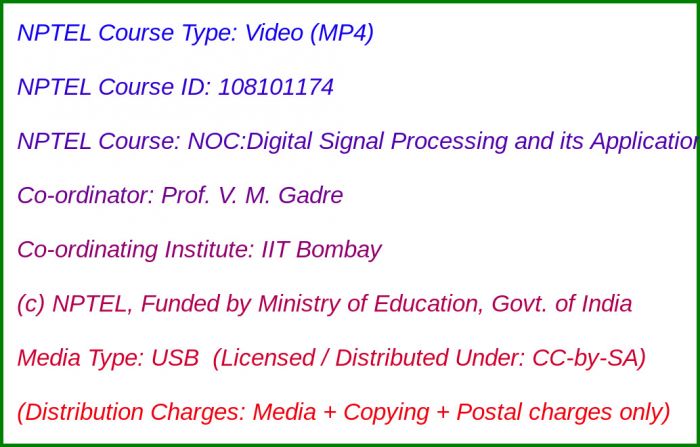NOC:Digital Signal Processing and its Applications

Media Storage Type : 32 GB USB Stick
NPTEL Subject Matter Expert : Prof. V. M. Gadre
NPTEL Co-ordinating Institute : IIT Bombay
NPTEL Lecture Count : 94
NPTEL Course Size : 3.6 GB
NPTEL PDF Text Transcription : Available and Included
NPTEL Subtitle Transcription : Available and Included (SRT)
Lecture Titles:
Lecture 1 - Introduction: Digital signal processing and its objectives
Lecture 2 - Introduction to sampling and Fourier Transform
Lecture 3 - Sampling of sine wave and associate complication
Lecture 4 - Review of Sampling Theorem
Lecture 5 - Idealized Sampling, Reconstruction
Lecture 6 - Filters And Discrete System
Lecture 7 - Answering questions from previous lectures
Lecture 8 - Desired requirements for discrete system
Lecture 9 - Introduction to phasors
Lecture 10 - Advantages of phasors in discrete systems
Lecture 11 - What do we want from a discrete system?
Lecture 12 - Linearity - Homogeneity and Additivity
Lecture 13 - Shift Invariance and Characterization of LTI systems
Lecture 14 - Characterization of LSI system using it’s impulse response
Lecture 15 - Introduction to convolution
Lecture 16 - Convolution: Deeper ideas and understanding
Lecture 17 - Characterisation of LSI systems, Convolution-properties
Lecture 18 - Response of LSI Systems to Complex Sinusoids
Lecture 19 - Convergence of Convolution and Bibo Stability
Lecture 20 - Commutativity and Associativity
Lecture 21 - BIBO Stability of an LSI system
Lecture 22 - Causality and memory of an LSI system
Lecture 23 - Frequency response of an LSI system
Lecture 24 - Introduction and conditions of Stability
Lecture 25 - Vectors and Inner Product
Lecture 26 - Interpretation of Frequency Response as Dot Product
Lecture 27 - Interpretation of Frequency Response as Eigenvalues
Lecture 28 - Discrete time fourier transform
Lecture 29 - DTFT in LSI System and Convolution Theorem.
Lecture 30 - Definitions of sequences and Properties of DTFT
Lecture 31 - Introduction to DTFT, IDTFT
Lecture 32 - Dual to convolution property
Lecture 33 - Multiplication Property, Introduction to Parseval’s theorem
Lecture 34 - Introduction and Property of DTFT
Lecture 35 - Review of Inverse DTFT
Lecture 36 - Parseval’s Theorem and energy and time spectral density
Lecture 37 - Discussion on Unit Step
Lecture 38 - Introduction to Z transform
Lecture 39 - Example of Z transform
Lecture 40 - Region of Convergence
Lecture 41 - Properties of Z transform
Lecture 42 - Z- Transform
Lecture 43 - Rational System
Lecture 44 - Introduction and Examples of Rational Z Transform and their Inverses
Lecture 45 - Double Pole Examples and their Inverse Z Transform
Lecture 46 - Partial Fraction Decomposition
Lecture 47 - LSI System Examples
Lecture 48 - Why are Rational Systems so important?
Lecture 49 - Solving Linear constant coefficient difference equations which are valid over a finite range of time
Lecture 50 - Introduction to Resonance in Rational Systems
Lecture 51 - Characterization of Rational LSI system
Lecture 52 - Causality and stability of the ROC of the system function
Lecture 53 - Recap of Rational Systems and Discrete Time Filters
Lecture 54 - Specifications for Filter Design
Lecture 55 - Four Ideal Piecewise Constant Filters
Lecture 56 - Important Characteristics Of Ideal Filters
Lecture 57 - Synthesis of Discrete Time Filters, Realizable specifications
Lecture 58 - Realistic Specifications for low pass filter. Filter Design Process
Lecture 59 - Introduction to Filter Design. Analog IIR Filter,FIR discrete-time filter, IIR discrete-time filter
Lecture 60 - Analog to discrete transform
Lecture 61 - Intuitive transforms, Bilinear Transformation
Lecture 62 - Steps for IIR filter design
Lecture 63 - Analog filter design using Butterworth Approximation
Lecture 64 - Butterworth filter Derivation And Analysis of butterworth system function
Lecture 65 - Chebychev filter Derivation
Lecture 66 - Midsem paper review discussion
Lecture 67 - The Chebyschev Approximation
Lecture 68 - Next step in design: Obtain poles
Lecture 69 - Introduction to Frequency Transformations in the Analog Domain
Lecture 70 - High pass transformation
Lecture 71 - Band pass transformation
Lecture 72 - Frequency Transformation
Lecture 73 - Different types of filters
Lecture 74 - Impulse invariant method and ideal impulse response
Lecture 75 - Design of FIR of length (2N+1) by the truncation method,Plotting the function V(w)
Lecture 76 - IIR filter using rectangular window, IIR filter using triangular window
Lecture 77 - Proof that frequency response of an fir filter using rectangular window function centred at 0 is real
Lecture 78 - Introduction to window functions
Lecture 79 - Examples of window functions
Lecture 80 - Explanation of Gibb’s Phenomenon and it’s application
Lecture 81 - Comparison of FIR And IIR Filter’s
Lecture 82 - Comparison of FIR And IIR Filter’s
Lecture 83 - Comparison of FIR And IIR Filter’s
Lecture 84 - Introduction and approach to realization (causal rational system)
Lecture 85 - Comprehension of Signal Flow Graphs and Achievement of Pseudo Assembly Language Code
Lecture 86 - Introduction to IIR Filter Realization and Cascade Structure
Lecture 87 - Cascade Parallel Structure
Lecture 88 - Lattice Structure
Lecture 89 - Recap And Review of Lattice Structure, Realization of FIR Function
Lecture 90 - Backward recursion, Change in the recursive equation of lattice
Lecture 91 - Lattice structure for an arbitrary rational system
Lecture 92 - Example realization of lattice structure for rational system
Lecture 93 - Introductory Remarks of Discrete Fourier Transform and Frequency Domain Sampling
Lecture 94 - Principle of Duality, The Circular Convolution

